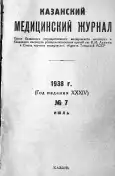К диагностике склероза легочной артерии (болезнь Айерза)
- Авторы: Гольник Р.Ф.1
-
Учреждения:
- Пропедевтическое отделение терапевтической клиники Воронежского медицинского института и 3-й клиническая больница (директор проф. А. А. Герке)
- Выпуск: Том 34, № 7 (1938)
- Страницы: 671-677
- Тип: Статьи
- URL: https://bakhtiniada.ru/kazanmedj/article/view/57644
- DOI: https://doi.org/10.17816/kazmj57644
- ID: 57644
Цитировать
Полный текст
Аннотация
В клинике внутренних болезней давно известна так называемая „синяя болезнь“ (Morbus coeruleus), характеризующаяся стойким и распространенным цианозом, охватывающим лицо, верхнюю часть туловища и конечности. Причиной таких синюх или, как их иногда называют, „чернух“ (из-за интенсивности синюшной окраски) большинство авторов считало врожденные пороки сердца (главным образом сужение легочной артерии)., ведущие к смещению артериальной и венозной крови. Но, начиная со второй половины XIX столетия ряд авторов (Лаше, Райх, Ауст, Адлер, Бриан) описывал случаи, сопровождавшиеся резким цианозом, одышкой и увеличением правого желудка, диагносцированные ими как врожденные пороки или пороки митральных клапанов, и где на секции не было найдено никакого порока, а был обнаружен склероз легочной артерии. Авторы обратили внимание на то обстоятельство, что в большинстве этих случаев не было обнаружено общего артериосклероза или склероза сосудов большого круга. Это заболевание стало привлекать к себе внимание врачей, и в 1901 году аргентинский клиницист Айерза сообщил о заболевании, причиной которого он считал распространенный склероз легочной артерии. Основными симптомами этого заболевания, по Айерзу, являются: постоянный и резкий цианоз головы, шеи, слизистой языка, глаз и конечностей, выраженная одышка, полиглобулия, сонливое состояние и гипертрофия и дилятация правого желудка. Сам автор назвал это заболевание Cardiacos negros, а в клинике оно получило название „болезни Айерза“. Спустя 7 лет — в 1908 г. Поссельт пишет уже о 170 случаях, собранных им в мировой, литературе, и о 10 собственных случаях, подтвержденных вскрытиями. Диагноз при жизни был поставлен в 7 случаях. Поссельт и другие авторы (Арриляга, Фризони) дополняют клиническую картину, описанную Айерза, постоянными головными болями, частыми кровохарканиями, на почве застоя в малом кругу кровообращения, и загрудинными болями, сопровождающимися чувством страха и беспокойства.
Ключевые слова
Полный текст
Открыть статью на сайте журналаОб авторах
Р. Ф. Гольник
Пропедевтическое отделение терапевтической клиники Воронежского медицинского института и 3-й клиническая больница (директор проф. А. А. Герке)
Автор, ответственный за переписку.
Email: info@eco-vector.com
Россия
Список литературы
- Буйневич, Клинические лекции, 1933.
- Соломин, Клин, мед., № 1 —2, 1933.
- Георгиевская и Потте, Клин, мед., №9, 1935
- Гельман и Сапожников, Тер. арх., в. V, 1935.
- Сосянц, Клин, мед., № 10, 1936.
- Тумашева, Каз. мед. ж., № 8, 1936
- Брумберг, Тер. арх., в. 3, 1934.
- Брумберг, Арх. пат. анат. и пат. физ., т. II, в. 2, 1936.
- Posselt, Die kliiic. Diagnose d. Pulmonaearterioscl, 1908.
Дополнительные файлы






